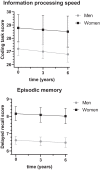Do Cardiovascular Risk Factors and Cardiovascular Disease Explain Sex Differences in Cognitive Functioning in Old Age?
- PMID: 33720886
- PMCID: PMC8150475
- DOI: 10.3233/JAD-201173
Do Cardiovascular Risk Factors and Cardiovascular Disease Explain Sex Differences in Cognitive Functioning in Old Age?
Abstract
Background: Sex differences in cognitive functioning in old age are known to exist yet are still poorly understood.
Objective: This study examines to what extent differences in cardiovascular risk factors and cardiovascular disease between men and women explain sex differences in cognitive functioning.
Methods: Data from 2,724 older adults from the Longitudinal Aging Study Amsterdam were used. Information processing speed and episodic memory, measured three times during six years of follow-up, served as outcomes. The mediating role of cardiovascular risk factors and cardiovascular disease was examined in single and multiple mediator models. Determinant-mediator effects were estimated using linear or logistic regression, and determinant-outcome and mediator-outcome effects were estimated using linear mixed models. Indirect effects were estimated using the product-of-coefficients estimator.
Results: Women scored 1.58 points higher on information processing speed and 1.53 points higher on episodic memory. Several cardiovascular risk factors had small mediating effects. The sex difference in information processing speed was mediated by smoking, depressive symptoms, obesity, and systolic blood pressure. The sex difference in episodic memory was mediated by smoking, physical activity, and depressive symptoms. Effects of smoking, LDL cholesterol, and diabetes mellitus on information processing speed differed between men and women.
Conclusion: Differences in cardiovascular risk factors between women and men partially explained why women had better cognitive functioning. A healthy cardiovascular lifestyle seems beneficial for cognition and sex-specific strategies may be important to preserve cognitive functioning at older age.
Keywords: Aged; behavior; cardiovascular diseases; cognition; epidemiology; episodic memory; sex.
Conflict of interest statement
Authors’ disclosures available online (
Figures



Similar articles
-
Women Outperform Men in Verbal Episodic Memory Even in Oldest-Old Age: 13-Year Longitudinal Results of the AgeCoDe/AgeQualiDe Study.J Alzheimers Dis. 2019;69(3):857-869. doi: 10.3233/JAD-180949. J Alzheimers Dis. 2019. PMID: 31127762
-
Long-Term Gender-Affirming Hormone Therapy and Cognitive Functioning in Older Transgender Women Compared With Cisgender Women and Men.J Sex Med. 2021 Aug;18(8):1434-1443. doi: 10.1016/j.jsxm.2021.05.013. Epub 2021 Jul 8. J Sex Med. 2021. PMID: 34247950
-
Sex Differences in Cognitive Functioning with Aging in the Netherlands.Gerontology. 2022;68(9):999-1009. doi: 10.1159/000520318. Epub 2022 Jan 4. Gerontology. 2022. PMID: 34983049 Free PMC article.
-
Sex Differences in Cognition Across Aging.Curr Top Behav Neurosci. 2023;62:235-284. doi: 10.1007/7854_2022_309. Curr Top Behav Neurosci. 2023. PMID: 35467294 Review.
-
Evidence for sex differences in cardiovascular aging and adaptive responses to physical activity.Eur J Appl Physiol. 2010 Sep;110(2):235-46. doi: 10.1007/s00421-010-1506-7. Epub 2010 May 18. Eur J Appl Physiol. 2010. PMID: 20480371 Free PMC article. Review.
Cited by
-
The Relative Importance of Vascular Risk Factors on Early Cognitive Aging Varies Only Slightly Between Men and Women.Front Aging Neurosci. 2022 Mar 28;14:804842. doi: 10.3389/fnagi.2022.804842. eCollection 2022. Front Aging Neurosci. 2022. PMID: 35418850 Free PMC article.
-
Associations of the Lipidome with Ageing, Cognitive Decline and Exercise Behaviours.Metabolites. 2022 Aug 31;12(9):822. doi: 10.3390/metabo12090822. Metabolites. 2022. PMID: 36144226 Free PMC article. Review.
-
Sex differences in cognitive performance persist into your 80s.Geroscience. 2025 Jun;47(3):4335-4348. doi: 10.1007/s11357-025-01585-x. Epub 2025 Mar 17. Geroscience. 2025. PMID: 40095190 Free PMC article.
-
No sex differences in the association between regional brain structure abnormalities and cognitive functioning in a geriatric memory clinic population.Aging Brain. 2025 May 4;7:100137. doi: 10.1016/j.nbas.2025.100137. eCollection 2025. Aging Brain. 2025. PMID: 40421403 Free PMC article.
-
Sex differences and modifiable dementia risk factors synergistically influence memory over the adult lifespan.Alzheimers Dement (Amst). 2022 Apr 1;14(1):e12301. doi: 10.1002/dad2.12301. eCollection 2022. Alzheimers Dement (Amst). 2022. PMID: 35386471 Free PMC article.
References
-
- Ferreira L, Ferreira Santos-Galduroz R, Ferri CP, Fernandes Galduroz JC (2014) Rate of cognitive decline in relation to sex after 60 years-of-age: A systematic review. Geriatr Gerontol Int 14, 23–31. - PubMed
-
- Andrew MK, Tierney MC (2018) The puzzle of sex, gender and Alzheimer’s disease: Why are women more often affected than men? Womens Health 14, 8.
Publication types
MeSH terms
LinkOut - more resources
Full Text Sources
Other Literature Sources
Medical

